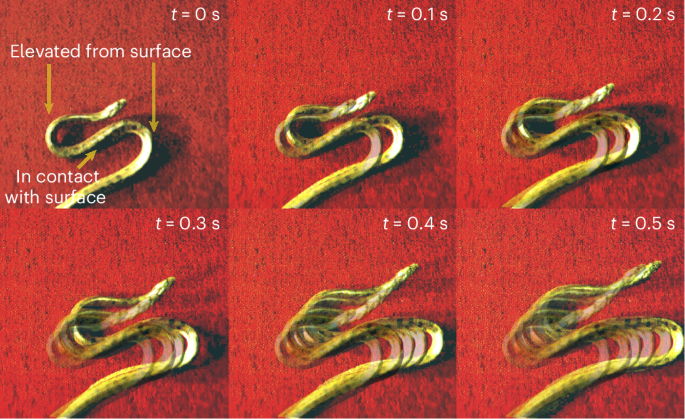Gray, J. Animal Locomotion (Norton,1968).
Marvi, H., Bridges, J. & Hu, D. Snakes mimic earthworms: propulsion using rectilinear travelling waves. J. R. Soc. Interface 10, 20130188 (2013).
Gray, J. & Lissmann, H. The kinetics of locomotion of the grass-snake. J. Exp. Biol. 26, 354–367 (1950).
Gasc, J., Cattaert, D., Chasserat, C. & Clarac, F. Propulsive action of a snake pushing against a single site: its combined analysis. J. Morphol. 201, 315–329 (1989).
Moon, B. & Gans, C. Kinematics, muscular activity and propulsion in gopher snakes. J. Exp. Biol. 201, 2669–2684 (1998).
Guo, Z. & Mahadevan, L. Limbless undulatory propulsion on land. Proc. Natl Acad. Sci. USA 105, 3179–3184 (2008).
Hu, D., Nirody, J., Scott, T. & Shelley, M. The mechanics of slithering locomotion. Proc. Natl Acad. Sci. USA 106, 10081–10085 (2009).
Alexander, R. Principles of Animal Locomotion (Princeton Univ. Press, 2013).
Biewener, A. & Patek, S. Animal Locomotion (Oxford Univ. Press, 2018).
Jayne, B. Kinematics of terrestrial snake locomotion. Copeia 1986, 915–927 (1986).
Gans, C. & Kim, H. Kinematic description of the sidewinding locomotion of four vipers. Isr. J. Zool. 38, 9–23 (1992).
Marvi, H. et al. Sidewinding with minimal slip: snake and robot ascent of sandy slopes. Science 346, 224–229 (2014).
Jayne, B. What defines different modes of snake locomotion? Integr. Comp. Biol. 60, 156–170 (2020).
Savidge, J., Seibert, T., Kastner, M. & Jayne, B. Lasso locomotion expands the climbing repertoire of snakes. Curr. Biol. 31, R7–R8 (2021).
Yeaton, I., Ross, S., Baumgardner, G. & Socha, J. Undulation enables gliding in flying snakes. Nat. Phys. 16, 974–982 (2020).
Fu, Q., Astley, H. & Li, C. Snakes combine vertical and lateral bending to traverse uneven terrain. Bioinspir. Biomim. 17, 036009 (2022).
Gart, S., Mitchel, T. & Li, C. Snakes partition their body to traverse large steps stably. J. Exp. Biol. 222, jeb185991 (2019).
Jayne, B. & Davis, J. Kinematics and performance capacity for the concertina locomotion of a snake (Coluber constrictor). J. Exp. Biol. 156, 539–556 (1991).
Alfaro, M. Forward attack modes of aquatic feeding garter snakes. Funct. Ecol. 16, 204–215 (2002).
Alfaro, M. Sweeping and striking: a kinematic study of the trunk during prey capture in three thamnophiine snakes. J. Exp. Biol. 206, 2381–2392 (2003).
Vincent, S., Herrel, A. & Irschick, D. Comparisons of aquatic versus terrestrial predatory strikes in the pitviper, Agkistrodon piscivorus. J. Exp. Zoo. A 303A, 476–488 (2005).
Alben, S. Efficient bending and lifting patterns in snake locomotion. Proc. R. Soc. A 478, 20220312 (2022).
Domenici, P. & Blake, R. The kinematics and performance of fish fast-start swimming. J. Exp. Biol. 200, 1165–1178 (1997).
Gazzola, M., Van Rees, W. & Koumoutsakos, P. C-start: optimal start of larval fish. J. Fluid Mech. 698, 5–18 (2012).
Kolinski, J., Aussillous, P. & Mahadevan, L. Shape and motion of a ruck in a rug. Phys. Rev. Lett. 103, 174302 (2009).
Rivas, J. et al. in Biology Of The Boas And Pythons (eds Henderson, R. W. & Powell, R.) 129–138 (Eagle Mountain Publishing, 2007).
Prange, H. & Christman, S. The allometrics of rattlesnake skeletons. Copeia 1976, 542–545 (1976).
Anderson, J., Rahn, H. & Prange, H. Scaling of supportive tissue mass. Q. Rev. Biol. 54, 139–148 (1979).
Garcia, G. & Silva, J. Interspecific allometry of bone dimensions: a review of the theoretical models. Phys. Life Rev. 3, 188–209 (2006).
O’Reilly, O. M. Modeling Nonlinear Problems in the Mechanics of Strings and Rods (Springer, 2017).
Gazzola, M., Dudte, L., McCormick, A. & Mahadevan, L. Forward and inverse problems in the mechanics of soft filaments. R. Soc. Open Sci. 5, 171628–171628 (2018).
Calugareanu, G. L’intégrale de Gauss et l’analyse des noeuds tridimensionnels. Rev. Math. Pures Appl. 4, 5–20 (1959).
Ricca, R. & Nipoti, B. Gauss’ linking number revisited. J. Knot Theory Ramif. 20, 1325–1343 (2011).
Fuller, F. The writhing number of a space curve. Proc. Natl Acad. Sci. USA 68, 815–819 (1971).
Tingle, J. Facultatively sidewinding snakes and the origins of locomotor specialization. Int. Comp. Bio. 60, 202–214 (2020).
Jayne, B. Muscular mechanisms of snake locomotion: an electromyographic study of lateral undulation of the Florida banded water snake (Nerodia fasciata) and the yellow rat snake (Elaphe obsoleta). J. Morphol. 197, 159–181 (1988).
